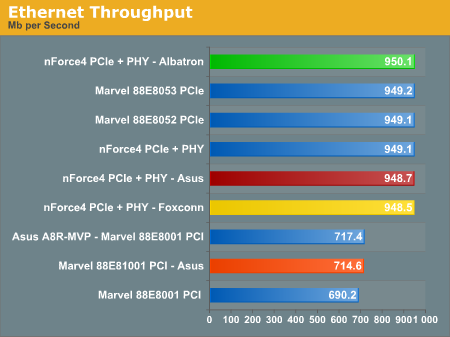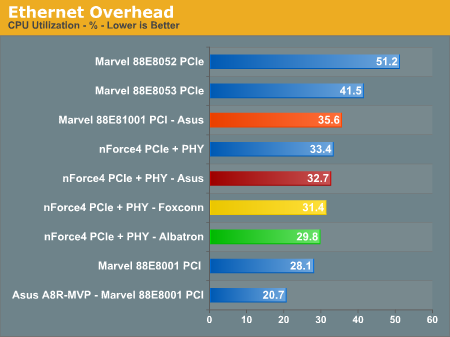nForce4 SLI Motherboards: Premium Performance at a Bargain Price
by Gary Key on January 3, 2006 12:05 AM EST- Posted in
- Motherboards
Ethernet Performance
The current motherboard test suite includes LAN performance measurements. All of these boards utilize PCI Express controllers with the only difference being the supplier of the core logic.
The Windows 2000 Driver Development Kit (DDK) includes a useful LAN testing utility called NTttcp. We used the NTttcp tool to test Ethernet throughput and the CPU utilization of the various Ethernet Controllers used on the motherboards.
We set up one machine as the server; in this test, an Intel system with an Intel CSA Gigabit LAN connection. Intel CSA has a reputation for providing fast throughput and this seemed a reasonable choice to serve our Gigabit LAN clients.
At the server side, we used the following Command Line as suggested by the VIA whitepaper on LAN testing:
All standard Ethernet tests were performed with standard frames and the NVIDIA Active Armor suite disabled unless otherwise noted. Gigabit Ethernet supports Jumbo frames as well and provides a further reduction in CPU overhead.
The current motherboard test suite includes LAN performance measurements. All of these boards utilize PCI Express controllers with the only difference being the supplier of the core logic.
The Windows 2000 Driver Development Kit (DDK) includes a useful LAN testing utility called NTttcp. We used the NTttcp tool to test Ethernet throughput and the CPU utilization of the various Ethernet Controllers used on the motherboards.
We set up one machine as the server; in this test, an Intel system with an Intel CSA Gigabit LAN connection. Intel CSA has a reputation for providing fast throughput and this seemed a reasonable choice to serve our Gigabit LAN clients.
At the server side, we used the following Command Line as suggested by the VIA whitepaper on LAN testing:
Ntttcpr -m 4,0,‹server IP› -a 4 -l 256000 -n 30000On the client side (the motherboard under test), we used the following Command Line:
Ntttcps -m 4,0,‹client IP› -a 4 -l 256000 -n 30000At the conclusion of the test, we captured the throughput and CPU utilization figures from the client screen.


All standard Ethernet tests were performed with standard frames and the NVIDIA Active Armor suite disabled unless otherwise noted. Gigabit Ethernet supports Jumbo frames as well and provides a further reduction in CPU overhead.










37 Comments
View All Comments
Gary Key - Wednesday, January 4, 2006 - link
As stated in the article the current pricing structure lends itself to the purchase of an SLI capable motherboard if the nForce4 is your chipset of choice. Even if you do not utilize SLI you at least have the option of doing so, if not for gaming, then for multiple monitor support and excellent performance utilizing two x8 lanes. If you look at the current support from the motherboard suppliers and product plans it is very obvious that SLI/CrossFire capable motherboards are becoming the standard across all price points. Our statements were based on these facts regarding the motherboard choices available. If you consider the potential cost/performance benefits then why pay the same amount of money for a board that is not capable of SLI or CrossFire and will probably not receive the same level of support over the lifespan of the product.
bob661 - Wednesday, January 4, 2006 - link
Isn't this a contradiction?
Capt Caveman - Tuesday, January 3, 2006 - link
What are you talking about? You can get a SLI board for $70.andlcool - Tuesday, January 3, 2006 - link
for the asus one, it should be ddr and not ddr2.ElFenix - Tuesday, January 3, 2006 - link
still, should be a good price for stock speed boardsElFenix - Tuesday, January 3, 2006 - link
looking at the first chart i mean. doesn't seem to fall off much eh?<--- wants an edit function
Gary Key - Tuesday, January 3, 2006 - link
The Foxconn board offered excellent stability throughout testing although it certainly is not targeted at the overclocking crowd. The performance was certainly acceptable and without the benchmarks you probably would not be able to tell the difference between it and the other boards. The layout is really nice unless you plan on utilizing two video cards with two slot cooling solutions as the space becomes very tight between the two x16 slots.I would like an edit function also. ;->